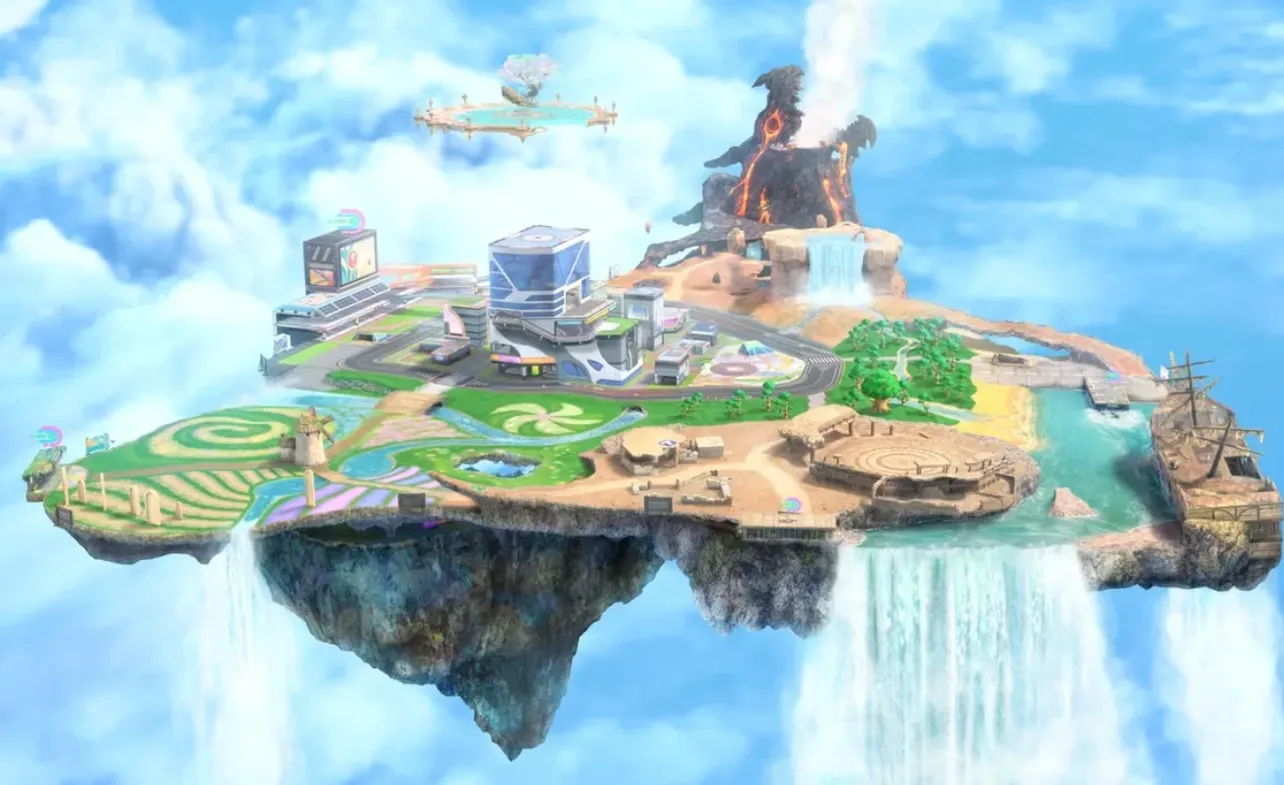Starman turns one of Kirby’s oldest Hi-Jump enemies into a fully playable rider in Kirby Air Riders. He’s built around vertical movement: leave the ground, catch any bit of air, and he can rocket past rivals who are still stuck on the track.
Who Starman is and how he plays
Starman is a long-running Kirby enemy that grants the Hi-Jump Copy Ability when inhaled. In Kirby Air Riders, he becomes a dedicated rider whose whole identity is “go up, then go fast.”
His in‑game description leans into this: he “excels at airborne maneuvers” and gains a speed burst from jumping, letting him glide over other machines. His Special, Super Starman, launches him high into the sky with a rainbow-colored cape, covering a lot of distance and often stealing stats from riders he hits on the way.
On the ground, Starman can feel underwhelming compared to more aggressive riders; his real power shows once he’s airborne, especially on machines with strong glide.
How to unlock Starman (all modes)
Starman is not available from the start. To add him to your roster permanently you have to clear two specific Checklist tasks, one in Top Ride and one in City Trial.
| Mode | Course / Board | Objective to complete | What it unlocks |
|---|---|---|---|
| Top Ride | Crystal | Finish 4 laps while holding the lead position the entire time. | Counts toward unlocking Starman / alternate colors |
| City Trial | Field board | Fall for 6 seconds after using Boost exactly once. | Counts toward unlocking Starman / alternate colors |
The first time you complete one of these Starman tasks on the Checklist, you gain Starman as a new rider. If you later fulfill another Starman square, you get an alternate color for him instead – for example, his red palette.
How the “fall for 6 seconds” condition works in City Trial
The City Trial requirement is very particular: you must Boost one time, then have your machine fall off the map and remain in the falling state until the game’s death timer hits six seconds.
A simple way to set this up:
- Pick any rider and enter City Trial with the standard City map.
- Mount a machine, then perform a single Boost on flat ground so the game registers one boost use.
- Head for an edge where you can drop a long way (for example, a cliff or the edge around the city’s outer ring).
- Drive off deliberately and do not Boost again while falling.
- If you remain in freefall until the respawn countdown hits six seconds, the Starman condition is satisfied on that run.
Starman’s stats and role in City Trial
Starman’s passive behavior makes machines lift off and glide more easily, but he is sensitive to how you build stats:
- Glide is his most important stat. Each point noticeably increases how long he can stay airborne and how quickly he can climb to high platforms, such as the sky island.
- Top Speed still matters, but mostly as “flight speed”; his effective speed skyrockets once he is in the air and repeatedly hitting ramps or boosters.
- Offense is a low priority. His plan is to outmaneuver rivals vertically, not bully them in melee.
- Weight is a double-edged stat. Higher weight can stabilize him when he’s moving quickly, but it also makes initial liftoff harder.
In practice, that means a Starman build that looks “weak” on the pad (modest top speed, huge Glide) can still shred Stadium events that reward airtime or long jumps.
Best machines and basic pairing logic
Starman works best on machines that either glide naturally or give him safe access to air ramps. The exact numeric “best machine” rankings are still being fleshed out, but his behavior with several core machines is already clear:
- Warp Star: The most forgiving choice. Turning is predictable, it handles ground sections well, and it can still catch big air with moderate Glide (around 3+) and a little Top Speed. Ideal if you want to learn Starman without fighting your machine.
- Paper Star: Extremely strong but risky. Its glide is enormous, letting Starman chain boosters and stay airborne for very long stretches. The downside is low durability – stray hits from bombs or Gordos can end a run abruptly.
- Winged Star: Looks like the obvious glide option, but tends to be awkward with Starman. It often feels “bait”: not as stable as Warp Star, not as explosively fast as Paper Star, and touchier in corners.
- Vampire Star: In short stadium races, combining Vampire Star’s bite with Starman’s aerial speed can end rounds quickly. A single successful hit into a ramp can decide a Short Race.
Overall, Starman needs either a high‑ceiling flyer (Paper Star, Flight Warp Star) or a balanced platform (Warp Star, Compact Star) and then a stat line that favors Glide and Top Speed over Offense.
How to build stats for Starman in City Trial
City Trial is where Starman’s design shows the most nuance. His stat priorities differ from bruiser riders:
| Stat | Priority for Starman | Why it matters |
|---|---|---|
| Glide | Highest | Directly controls how early he can reach floating platforms and how long he can “fly” between ramps. |
| Top Speed (Speed) | High | Increases both ground and air speed; essential once Glide is solid. |
| Boost | Medium | Helps reach air ramps quickly, but he gains plenty of speed from flight and boosters already. |
| Turn / Control | Medium | Makes it easier to line up thin ramps and rings while moving very fast. |
| Offense | Low | Offers little benefit to his main plan of staying airborne. |
| Defense / HP | Situational | Valuable if you’re on fragile machines like Paper Star and expect heavy combat. |
A typical “good” Starman build for City Trial might end at something like high Glide (5–7), high Speed (12–17), modest Boost, and passable Control. Even with a low printed Top Speed on the pad, his real speed spikes in the air to the point that he can keep up with heavily stacked rivals on the ground.
Where to farm stats as Starman in City Trial
Starman struggles to win head‑on fights over dense item zones like the crystal caves. He performs better when he uses his glide kit to exploit areas others ignore.
Patterns that work well:
- Underground tunnels: Boxes here are easy to scoop up without much contest, especially early. You can often leave the caves with several Glide and Speed pieces before other players are fully set up.
- Volcano and high platforms: If you pick up the “machines fly more easily” temporary effect or get enough Glide, you can reach the volcano’s upper rings earlier than most riders, turning it into a private stat farm for a minute or two.
- Floating rings and rails: Once your Glide hits certain breakpoints (around 5+ with moderate Speed), you stop needing gimmicks; a short liftoff is enough to grab airborne rings consistently.
Using Starman’s Special effectively
Super Starman is more than a flashy escape button. It fills a few key roles:
- Gap closer: In stadium races like Oval Circuit or Drag Race 3, triggering Super Starman after a ramp lets you leapfrog traffic and sometimes bypass entire corners.
- Stat thief and disrupter: If you collide with riders while in Super Starman, you can hurt them and steal some of their stats, which can swing City Trial late games.
- Consistency tool for Target Flight: In Target Flight, his Special can stabilize long‑distance attempts, making it easier to repeatedly land on the 100‑point targets once you have enough Speed.
Super Starman charges by picking up items and damaging enemies. It’s usually not worth forcing fights purely to build it; in City Trial, it will naturally become available if you’re actively collecting boxes and clearing small enemies on the way to your next route.
Which Stadiums favor Starman
Starman’s kit translates better to some Stadium events than others.
| Stadium | How Starman performs | Why |
|---|---|---|
| Target Flight | Very strong | High Glide and flight speed make it trivial to hit far targets; with enough Speed, he can consistently reach 100‑point plates. |
| Air Glider | Strong | Any mode that scores airtime or distance plays directly into his glide‑focused design. |
| High Jump / Glide tests | Variable | He needs both Glide and a compatible machine; a Winged Star with stacked glide can outpace a Warp Star with pure Speed. |
| Drag Race 3 | Situationally strong | Drag Race 3 includes airtime segments and ramps that let airborne builds abuse shortcuts. |
| Standard derbies and Short Race | Skill‑dependent | He can win by chaining ramps and Specials, but heavy ground‑based speed builds on Warp Star or Turbo Star can still outpace him if you miss jumps. |
In many City Trial lobbies, Target Flight ends up being the “safe” pick when you’re on an extreme Glide build; if other players neglect flight stats, Starman can turn that into a free win.
Racing with Starman in Air Ride and Top Ride
Outside City Trial, Starman still leans on the same principles but asks for more precision.
- Air Ride races: Practice on tracks with big jumps such as Fantasy Meadows or Beanstalk Park. Learn where you can safely catch “accidental” air off small bumps, because even minor liftoff can trigger significant speed boosts if you’re already gliding well.
- Braking and cornering: Starman stops sharply on many machines, which means tapping the brake before tight corners can line you up for the next ramp instead of sending you wide.
- Top Ride Crystal unlock: While working on his Top Ride condition (4 laps in the lead on Crystal), focus more on clean lines and item usage than constant aggression. Being bumped out of first for even a second can waste an otherwise good attempt.

Starman is one of the clearest examples of Kirby Air Riders turning a quirky enemy into a fully realized playstyle. Unlocking him only takes two specific checklist tasks, but mastering him means thinking in three dimensions at all times: where the boxes are now, where the ramps are next, and how soon you can leave the ground again.


